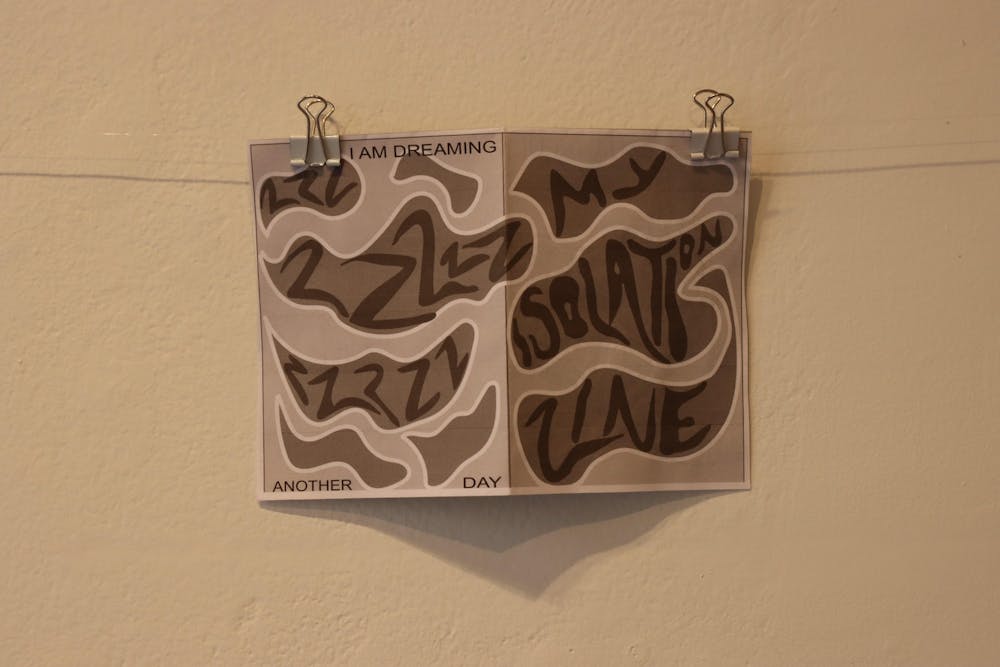Sleepy Cyborg Galley kicks off semester with virtual exhibit, “Quaranzine”

In a world becoming increasingly dependent on dual-delivery, one has to ask how visual art, a mode of communication previously relegated mostly to the physical, is adapting to the ongoing COVID-19 pandemic. An example of this dual-delivery form of visual art can be found at the newly renamed, student-run Sleepy Cyborg Gallery in their first exhibition of the year called “quaranzine.”
“A zine is a self-produced and published publication … that pulls from a DIY idea of what it means to make a booklet of images and words,” Isabel Samperio, director of Sleepy Cyborg Gallery, said.
Normally, zines are a very physical form of art. They’re meant to be opened and touched and looked at, interactions that are now impossible given the current COVID-19 restrictions.
“Quaranzine” is located in the small, white room on the bottom floor of Sewall Hall where past iterations of Sleepy Cyborg Gallery — Inferno Gallery and Matchbox — have also been housed.
The exhibit consists of approximately 15 student-made booklets displayed on the walls with string and clips. The zines vary from small collections of poems written on copy paper to colorful images of plants and animals on construction paper. One piece is supposed to be a paper fortune teller, the kind one would make in elementary school, covered in intricate black drawings and small, handwritten fortunes. Each piece has a printed QR code taped underneath that, when scanned, shows a video of a hand on the concrete floor of the space flipping through the booklets to reveal all the sides and pages of the student’s piece.
Samperio explained that she thought the flexibility of being online was actually a benefit for the gallery.
“The amount of people that we would be engaged with … would be crazy,” Samperio said. “There’s just so much convenience there and accessibility.”
According to Samperio and Gabrielle Feuillet, the exhibit was intended in part as a statement on the current politicization of the United States Postal Service, as all of the art had been sent through the mail. In fact, in the show there was a small pile of envelopes and stamps encouraging those who viewed the show to send a letter themselves. Feuillet said that even though the zines started as a way of connecting with friends that felt much more meaningful than other digital forms of communication.
“Quaranzine” uses the circumstances of social distancing and virtual interaction as an opportunity to juxtapose physical art forms with our new, highly digitized reality while simultaneously making art more remotely accessible.
You can visit Sleepy Cyborg’s new show “Quaranzine” in person by emailing the director to set up a viewing appointment at sleepycyborggallery@gmail.com, or view their online gallery at matchbox.rice.edu.
More from The Rice Thresher

Acting like an athlete: Rice basketball alum takes on Broadway
Underneath Chadd Alexander’s Broadway costume, there’s ankle tape and wrist braces — same protective gear he wore as a walk-on basketball player at Rice, though now he’s performing eight shows a week in the ensemble of “Harry Potter and the Cursed Child” instead of running conditioning drills in Tudor Fieldhouse.
“Love Island” Season 7: A Messy, Magnetic Reality Show
It was my first time watching “Love Island,” and I get it now. There's a cycle to this show: you swear you won't get sucked in, you dismiss it as background noise, and then, one week later, you're canceling plans just to hear a group of twenty-somethings debate the meaning of the word "exploring." The truth is, “Love Island” has plenty of flaws. It’s too long, too produced and too ridiculous, but I'll be the first to admit it: I'm already planning to watch next season.
Review: “F1: The Movie” puts pedal to the metal
Joseph Kosinski, Claudio Miranda and Jerry Bruckheimer — the trio behind “Top Gun: Maverick” — return to high-octane spectacle with “F1,” a sports drama that blends spectacle with surprising humanity. It’s loud, stylish and frequently overwhelming, but it’s also one of the most engaging racing movies in years.


Please note All comments are eligible for publication by The Rice Thresher.